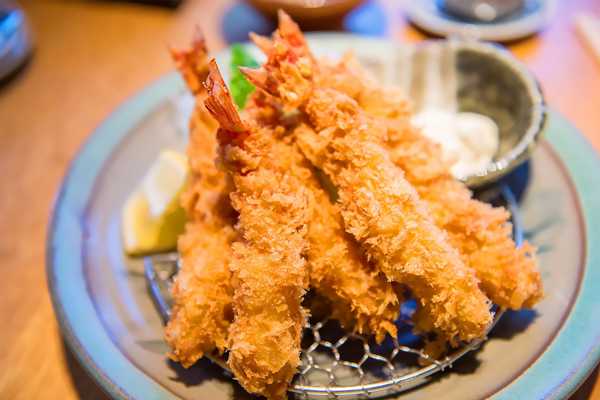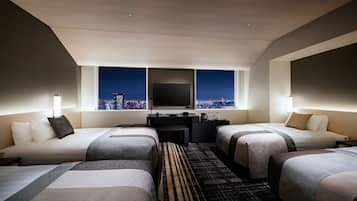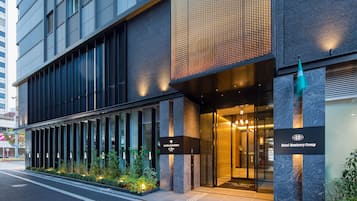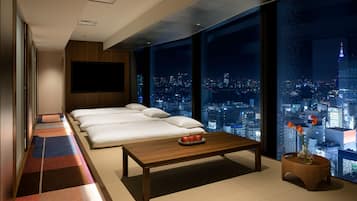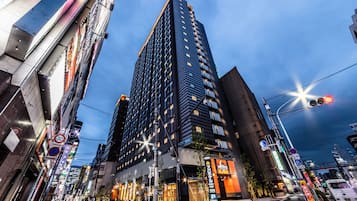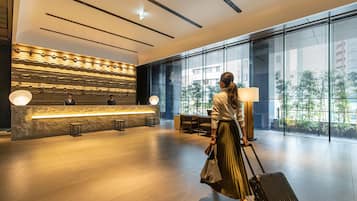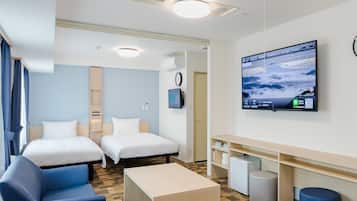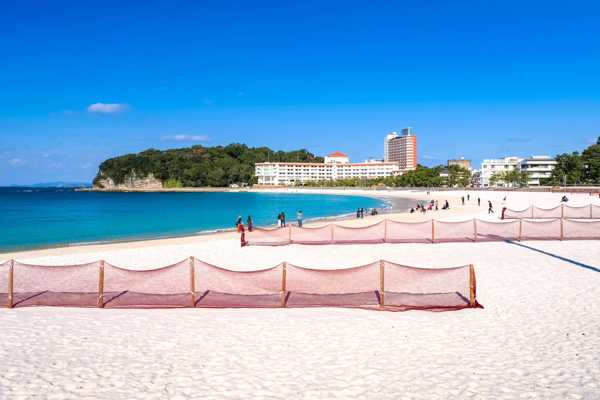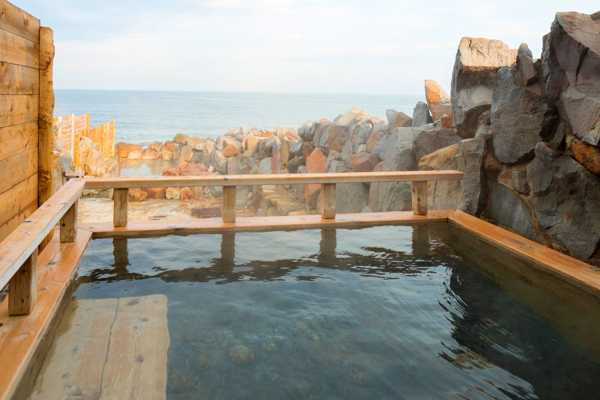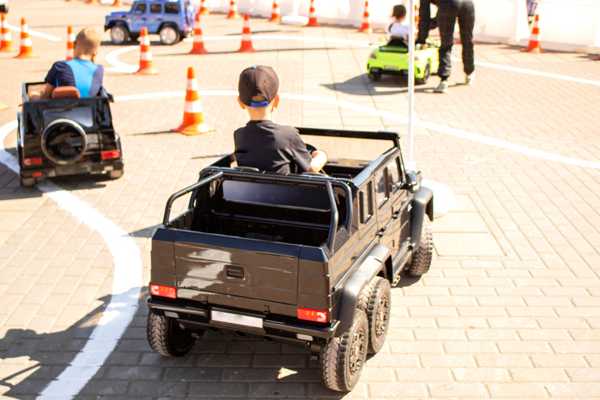Japan is an island country that stretches long from north to south and is surrounded by waters, but it also has spectacular mountain ranges with peaks in the region of 3,000 metres high. From emerald green sea with coral reefs to heavy snowfall in the mountains, Japan's variety of land and climate is unmatched. In these beautiful natural settings you'll find historic buildings, local customs and even modern art. If you're a keen photographer, a tour of Japan in search of vivid, photogenic and fascinating scenery will be a great way of building your portfolio.
- 1
Shirogane Blue Pond
A mysterious pond of glowing blue water

- Couples
- Families
- Photo
This so-called "Blue Pond" gets its name from the bizarre blue tone of water collected at a weir built to prevent disasters on Mt. Tokachi. Withered larches protrude from the surface of the water, making for an oddly fantastic landscape. The blue changes shade, running the gamut from cobalt blue to emerald green, depending on the viewing angle, time of day, and season. Each seasons brings another beautiful contrast, with fresh green leaves in springtime, autumn leaves, and spectacular snow-covered trees in wintertime. The site shot to fame after being featured in a photobook by a local photographer, but it became world-famous when Apple adopted it as wallpaper for Mac OS.
Location: Shirogane, Biei, Kamikawa District, Hokkaido 071-0235, Japan
Map - 2
Hashima Island
An abandoned sea-based mining facility turned World Cultural Heritage Site

- Couples
- Families
- History
- Photo
- Unusual
Hashima Island is a small island off the coast of Nagasaki. The high-quality coal that was mined from the seabed here played a huge role in the modernisation of Japan. Land was reclaimed, the shoreline was protected, and Japan's first reinforced concrete high-rise apartments were built here so that workers could live on the island. From a distance the island looks like a warship floating in the sea, hence its alternate name of Gunkanjima (literally "Battleship Island"). At its peak, the island had a population of about 5,300, making it the most densely populated place in the world at one time. But after the closure of the coal mine in 1974 it became what it is today: an eerie uninhabited island. Tourists now come to explore the dark scenery of the ruins left behind. The only way to visit is on a tour, but it's well worth making an excursion if you want to see something completely different.
Map - 3
Shima Mediterranean Village
A Spanish landscape surrounded by Japanese sea and forest

- Couples
- Families
- Luxury
- Photo
Shima Mediterranean Village is surrounded by the beautiful natural environment of Shima and Ago Bay. This is a unique resort hotel that recreates a Spanish city facing the Mediterranean Sea, only in Japan. The lively streets of Mykonos or Menorca, the hammam of the Alhambra, the Castile region, Sardinia and the towns and buildings of Andalusia are all reproduced in detail. A Spanish designer has worked with building materials ordered from Spain to make everything look perfectly Mediterranean. Make sure you stick around until the evening to check out the sunset in Ago Bay, which has been selected as one of Japan's top 100 sunsets. Even a day trip here will provide an experience to remember.
Location: 2619-1 Hamajimachō Hazako, Shima, Mie 517-0403, Japan
Phone: +81(0)599-52-1226
Map - 4
Takeda Castle Ruins
A castle in the sky that floats in the morning mist

- Couples
- Families
- History
- Photo
Takeda Castle was built during the Muromachi period. It was abandoned after the Battle of Sekigahara, but a magnificent stone wall remains at the summit of Mt. Kojo at an altitude of 353.7 metres, so the site still gives a powerful impression of Japan's Warring States period. You'll enjoy great views at any time of year, but the sea of clouds that appears from late autumn to spring is particularly beguiling. The ruins are perched above the clouds at such times, which is why the site is best known for its position as a "castle in the sky". Climb up to the Takeda Castle Ruins and you'll be able to view the sea of clouds from the inside, which is a really unusual experience. And if you want to get an overview of the whole scene from a distance, with the ruins of the castle apparently floating in the sea of clouds, go up to the Tachiunkyo observatory spot on Mt. Asago, which stands opposite the ruins.
Location: 169 Takeda Kojozan, Wadayama-cho, Asago-shi, Hyogo 669-5252, Japan
Open: March—May: from 8 am to 6 pm June—August: from 6 am to 6 pm September—November: from 4 am to 5 pm December—January 3: from 10 am to 2 pm January 4—end of February: no admission
Phone: +81(0)79-672-4003
Map - 5
21st Century Museum of Contemporary Art, Kanazawa
The leading museum of contemporary art in a city of traditional crafts

- Couples
- Families
- Photo
Set in the middle of Kanazawa, this is a super-accessible park-like museum that opens into the city. It opened in 2004 as a museum that collects and exhibits mainly contemporary art. The museum's circular all-glass structure makes it impossible to tell the front from the back, and you're free to enter and exit from any of the four entrances/exits. As well as many permanent exhibits that you can enjoy free of charge, you'll also find a swimming pool, a color activity house, and rabbit chairs, all of which are must-sees.
Location: 1-2-1 Hirosaka, Kanazawa City, Ishikawa Prefecture 920-8509, Japan
Open: Exhibition Zone: 10 am to 6 pm (until 8 pm on Fridays and Saturdays) Exchange Zone: 9 am to 10 pm
Phone: +81(0)76-220-2800
Map - 6
Yoron Island
A nature-rich southern island floating in bright blue waters

- Couples
- Families
- Photo
Yoron Island is located at the southernmost tip of the Amami Islands. This island of coral reefs is surrounded by a beautiful sea referred to as "Yoron Blue" for its distinctive shade. Tropical flowers such as hibiscus and bougainvillea bloom all year round, and there's amazing harmony between the blue sea, white sandy beaches and green trees. Make sure you visit Yurigahama, which is a white sand beach that appears only at low tide. The pure white sandy beach set against the bright blue sea looks stunning. The Southern Cross Center is a facility taking its name from the fact that the Southern Cross constellation can be seen from Yoron Island. There are great views to be had from the observatory on the top floor, and on sunny days you can sometimes see the main island of Okinawa to the south.
Map - 7
Itoshima
A fun spot where you can enjoy sea and mountains

- Couples
- Families
- Photo
Itoshima is a city situated in the westernmost part of Fukuoka Prefecture. Facing the Genkai Sea, it combines the best of both sea and mountain scenery. The coast is lined with famous places like Sakurai Futamigaura, which has been selected as having one of the 100 best sunsets in Japan, Keya no Ohto with its magnificent rock formations, the singing sand of Anego no Hama beach, as well as trendy Insta-friendly spots where you'll find swings made of palm trees and beaches with cafés. A boat trip to Himeshima is also well worth it. There's also refreshing mountain scenery at Shiraito Falls, Senjuin Falls and elsewhere. And top of all that, there are beautiful shrines and temples such as Raizan Senryoji Temple, which is famous for its autumn colours.
Map - 8
Yasaka Koshindo
An Instagram-worthy spot full of colourful hanging talismans

- Couples
- Families
- History
- Photo
Kongoji Temple is right next to Yasaka Tower in Higashiyama, Kyoto. This temple is more commonly known as Yasaka Koshindo. Colorful cloth amulets called "Kukuri Monkeys" hang like bells in the temple precincts, providing one of the most vivid and popular Instagrammable spots in Kyoto. These charms take the form of immobile monkeys whose limbs are tied up. It might seem a bit strange, but the idea is that stopping the monkey from acting as they wish, humans will also be warned not to simply follow their desires. If you look around, you'll also be able to find monkey sculptures and amulets connected to the Metal Monkey zodiac.
Location: 390-1 Kinencho, Higashiyama-ku, Kyoto City, Kyoto Prefecture 605-0828, Japan
Open: Open daily from 9 am to 5 pm
Phone: +81(0)75-541-2565
Map - 9
Towada Art Center
Enjoy art both inside and outside the museum

- Couples
- Families
- Photo
Towada Art Center opened in 2008 as an open facility providing new experiences through art. Make sure you check out the works by international artists including the likes of Yayoi Kusama and Ron Mueck. The museum has several exhibition rooms connected by glass passageways. Wandering from between the individual exhibition rooms feels like walking around a small town. Even the exterior and walls of the museum are packed with contemporary art, and the idea is that the whole street looks like a single museum. There's nowhere else quite like it.
Location: 10-9 Nishi 2-bancho, Towada City, Aomori Prefecture 034-0082, Japan
Open: Open daily from 9 am to 5 pm
Phone: +81(0)176-20-1127
Map - 10
Gokayama
One of Japan's quintessential snowy scenes

- Couples
- Families
- History
- Photo
This beautiful mountain village retains some wonderfully nostalgic Japanese scenery from times gone by. Gokayama is a nature-rich area along the Shogawa River at the southwestern tip of Toyama Prefecture. People still live in the region's many traditional Japanese houses with steep thatched roofs. Given that this area has some of the heaviest snowfall in Japan, the steep roofs are designed to make it easier to remove the wet and heavy snow that accumulates on the rooftops. One of the interesting features of these houses is that the front, where the snow doesn't tend to drop. Two of the villages in which these houses remain, Ainokura and Sugenuma, became UNESCO World Heritage Sites in 1995. Gokayama is also home to a rich songbook of folk culture and you should be able to enjoy performances of local folk songs when you visit.
Open: Ainokura Village: open daily from 8.30 am to 5 pm Suganuma Village: open daily from 8 am to 5 pm (April—November) and 9 am to 5 pm (December—March)
Map


